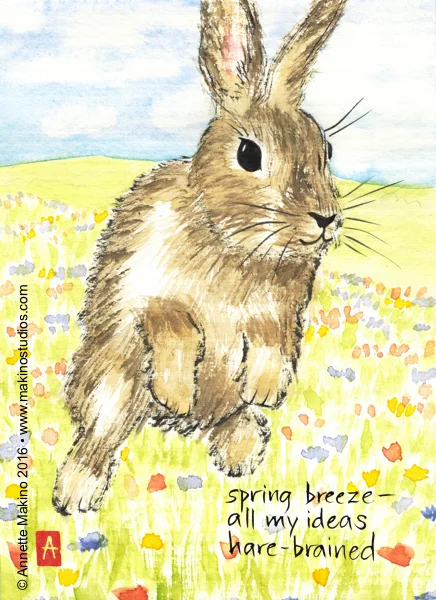Want to explore?
There are some wonderful sites to learn more about haiku, senryu and other forms of Japanese poetry, and to see examples of haiga, which is artwork combined with haiku. Here are a few great sources; many of these sites in turn have extensive lists of links.
"spring breeze" is 5x7, painted with Japanese watercolors and sumi ink on paper. © Annette Makino 2016
Haiku and Senryu
Definitions of haiku and senryu on the website of the Haiku Society of America
Definition of haiku by Ray Rasmussen
Definition of senryu by Ray Rasmussen
Becoming a haiku poet, essay by Michael Dylan Welch
Haiku Society of America, a not-for-profit organization promoting haiku poetry in English
The Haiku Foundation, a website promoting English-language haiku
The Heron’s Nest, a quarterly journal of haiku
Modern Haiku, a journal of haiku and haibun
Frogpond, a journal of haiku, senryu and haibun published by the Haiku Society of America
Acorn, a biennial journal of contemporary haiku
tinywords, an international daily magazine of haiku and micropoetry
Prune Juice, an online journal of contemporary senryu and kyoka
Graceguts, an online poetry journal by haiku poet Michael Dylan Welch
“empty bowl” is 5×7, painted with sumi ink and Japanese watercolors on paper. © Annette Makino 2016
Haiga
Definition of haiga by Ray Rasmussen
Daily Haiga, an edited journal of contemporary and traditional haiga
Contemporary Haibun Online, promoting English-language haibun and haiga
More
Haiku, Haibun, Haiga by Ray Rasmussen— a list of links to haiku journals and more
List of haiku organizations by The Haiku Foundation
Haiku, Senryu, and Haiga
Haiku is a genre of poetry that emerged in Japan in the 17th century. These short but profound poems are traditionally focused on an aspect of the season and juxtapose two images or ideas.
It is commonly believed that haiku in English must have five syllables in the first line, seven syllables in the second line, and five syllables in the third. However, most serious practitioners of English language haiku do not follow this 5-7-5 format, typically writing shorter three-line poems that more closely match the feel of seventeen on, or sounds, in Japanese.
Senryu, which follow the same structure as haiku, emerged in Japan in the 18th century. These poems are focused on human nature and are often humorous or philosophical. There is a gray area between haiku and senryu, and the term haiku may encompass both forms.
Haiga are works of art that include haiku. In a haiga, the words and image are combined in a way that goes beyond illustration to add depth and dimension to each. While they are traditionally painted with sumi ink on rice paper, today variations of haiga are created in a range of mediums, including photography and digital art.
See the links at left for much more detailed discussion and examples of all these art forms.



